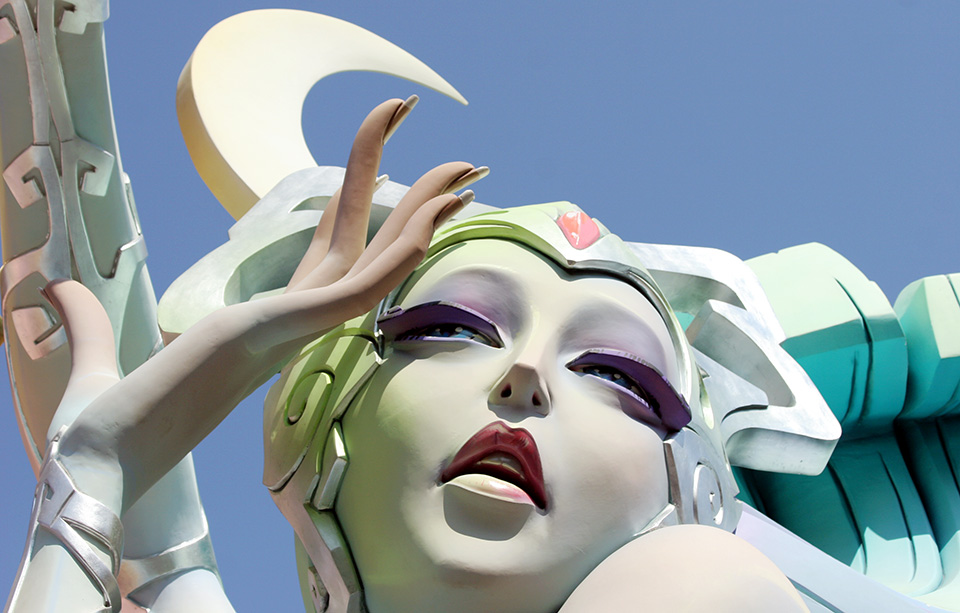Lights, gunpowder, monuments, flowers, traditional costumes, music, satire, emotions and a great deal of fun are the ingredients of a unique cocktail known as the Fallas Fiestas.
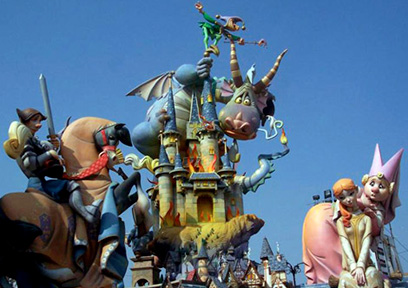
In the middle of the Mediterranean coast, Valencia city, celebrates each year the final days of the winter and the arrival of spring with spectacular fires and pyrotechnics. From March 15 to 19 (the feast of Saint Joseph, day of the father in the whole country), Valencia is given over to a carnival of bonfires, fiesta, fireworks and a healthy dose of satire known as Las Fallas, the fires. Displayed on every corner all over the city are colourful ninots, giant papier-mâché figures often 20 feet tall or even more that have been paraded through the streets and then placed in fantasy groups to tower over excited spectators. Each one in some way satirises a political figure, or a soap star, or more exotic creatures from the movies, TV, sports idols, or simply imagination. Some of them are grotesque – others playful and charming – all are larger than life and up for public scrutiny.
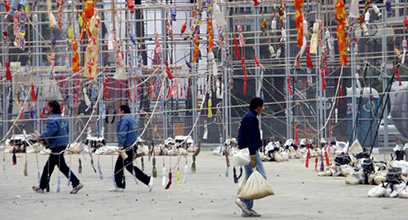
Every day at 2pm firecrackers rip through the Plaza del Ayuntamiento in an noisy event called la Mascleta. This concert of gunpowder is very popular and involves different neighbourhood groups competing for the most impressive volley, ending with the terremoto, (literally means "earthquake") as hundreds of masclets exploting simultaneously. While this may not be for the frail or faint-fainthearted, you understand how hearted, the Valencians got their valiant name.
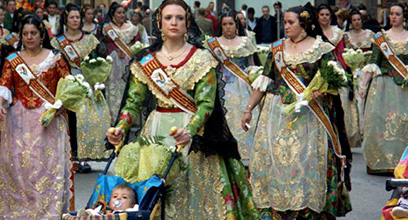 Another important event is the Ofrenda de Flores a la Virgen de los Desamparados, a beautiful ceremony every March 17 and 18, that honours Valencia's patron Virgin. Thousands of Falleras and Falleros arrive to the city from every corner of the Comunitat (Valencia State) and take the streets wearing traditional costumes and dancing to their neighbourhood or village bands as they wend their way to the Plaza de la Virgen to offer bouquets to the giant image of the Virgin.
Another important event is the Ofrenda de Flores a la Virgen de los Desamparados, a beautiful ceremony every March 17 and 18, that honours Valencia's patron Virgin. Thousands of Falleras and Falleros arrive to the city from every corner of the Comunitat (Valencia State) and take the streets wearing traditional costumes and dancing to their neighbourhood or village bands as they wend their way to the Plaza de la Virgen to offer bouquets to the giant image of the Virgin.
Historians say that the origins of the festival go back to the time when carpenters cleared out their workshops and talleres at the end of winter, throwing out odds and ends of wood and old candles and lighting them on the street the day of Saint Joseph.
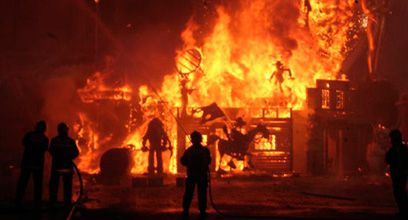
Nowadays, celebrations draw to an end with a fabulous firework display in the Paseo de la Alameda, called the Nit del Foc (literally "The Night of Fire"), on March 18. All Fallas burn all over the city the Crema night (including the winner of the competition) in a tremendous spectacle of fire and joy. Valencia is at that moment like Nero's Rome, a city in flames. That's why Valencians call this the best firework fiesta in the world! Don´t miss it!
The Fallas Programme 2025
The official programme offers a diverse range of activities that run through March, intensifying as the Fallas week approaches. Decorative lighting covers the 370 falla group headquarters spread throughout the city. Valencia becomes an immense and unparalleled museum, born to be destroyed, once its mission is accomplished: the exposure of the negative side of life, exposed to be ridiculed and incinerated.
1 March
- 2 pm. Mascleta (Plaza del Ayuntamiento).
2 March
- 2 pm. Mascleta (Plaza del Ayuntamiento).
- 5:30 pm. Children's ninot parade: Glorieta - Calle La Paz - San Vicente - Plaza del Ayuntamiento - Marqués de Sotelo - Calle Jativa.
8 March
- 2 pm. Mascleta (Plaza del Ayuntamiento).
- 6 pm. Mascleta (Las Arenas Beach).
- 10:30 pm. Ninot Parade (Route: Calle Jativa - Marqués de Sotelo - Maria Cristina - Plaza del Ayuntamiento - Marques de Sotelo - Jativa).
- Firework display.
11 March
- 2 pm. Mascleta (Plaza del Ayuntamiento).
12 March
- 2 pm. Mascleta (Plaza del Ayuntamiento).
13 March
- 2 pm. Mascleta (Plaza del Ayuntamiento).
14 March
- 2 pm. Mascleta (Plaza del Ayuntamiento).
- 6 pm. Closing ceremony of the Ninot Infantil Exhibition.
15 March
- 8 am. Setting up (la Planta) of all the children’s fallas.
- 2 pm. Mascleta (Plaza del Ayuntamiento).
- 6 pm. Closing ceremony of the Ninot Exhibition.
- 12 pm. Setting up (la Planta) of all the Fallas.
- 1:30 am. Firework display (Paseo de la Alameda).
16 March
- 2 pm. Mascleta (Plaza del Ayuntamiento).
- 4:30 pm. Children’s Fallas Award Ceremony.
- 10:30 pm. Cabalgata Folklórica (procession with examples of regional festivals).
- 1:30 am. Firework display (Paseo de la Alameda).
17 March
- 9:30 am. Fallas Award Ceremony.
- 2 pm. Mascleta (Plaza del Ayuntamiento).
- 4 pm. Floral offering to Virgen de los Desamparados (Our Lady of the Forsaken).
- 1:30 am. Firework display (Paseo de la Alameda).
18 March
- 11 am. Mascleta (Plaza del Ayuntamiento). Tribute to the poet Maximiliano Thous (Calle Sagunto).
- 12 pm. Mascleta (Plaza del Ayuntamiento). Tribute to Maestro Serrano (Avenida Reino de Valencia).
- 2 pm. Mascleta (Plaza del Ayuntamiento).
- 4 pm. Floral offering to Virgen de los Desamparados (Our Lady of the Forsaken).
- 2:00 am. Firework display (Paseo de la Alameda).
19 March
- 11 am. Floral offering to St. Joseph (St. Joseph Bridge).
- 12 pm. Solemn Mass to honour St Joseph the Patriarch (The Cathedral).
- 2 pm. Mascleta (Plaza del Ayuntamiento).
- 7 pm. Procession of Fire (from Calle Ruzafa, Calle Colon, to end in Porta de la Mar).
- 10 pm. Crema (Burning) of the children’s Fallas.
- 10:30 pm. Crema (Burning) of the children's Falla awarded first prize in the Special Section.
- 11 pm. Crema (Burning) of the Plaza del Ayuntamiento children’s Falla.
- 00 am. Crema (Burning) of all the Fallas of Valencia.
- 00:30 am. Crema (Burning) of the Falla awarded first prize in the Special Section.
- 1 am. Firework display (Plaza del Ayuntamiento).
The Fallas Pictures
For Photos of Fallas Fiesta in Valencia, Spain, visit: Fallas Pictures Gallery
Fallas of the Special Section
- Nou Campanar.
- Exposicion - Micer Masco.
- Almirante Cadarso - Conde Altea.
- Sueca - Literato Azorin.
- Convento Jerusalen.
- Plaza Na Jordana.
- Plaza del Pilar.
- Regne de Valencia - Duc de Calabria.
- Pizarro - Cirilo Amoros.
- Plaza de la Merced.
- Cuba - Literato Azorin.
- Archiduque Carlos - Chiva.
- Av. Malvarrosa - Antonio Ponz - Cavite.
- L' Antiga.
La Crida
It all starts at the end of February. From the ancient Torres de Serranos, the Fallera Mayor (the Queen of the Fallas), chosen from all the falleras of the city, issues the Crida: a call to her people and to everyone to come and join in the festivities. It is the beginning of an unforgettable experience: the Fallas.
Fallas Museum
On their first visit to this Fallas Museum, today located in a former Vincentian convent, may find it hard to understand what exactly a falla is and what this Museum means. Basically, fallas can be described as satirical monuments. They are models made of combustible materials (cardboard, wood, etc.) that are erected in public squares and at main crossroads and then burnt on the night of 19 March, St Joseph's Day.
The monuments are made by specialist falleros with the help and encouragement of resident's committees in all the different districts that spend the whole year preparing the annual festivities.
On completion, each fallero chooses the figure he considers the most successful and, a few weeks before the plantà when the monuments are moved out to the streets, all of these figures (ninots) are placed on display. The general public can then vote for the ninot they consider the most attractive, clever or amusing and it is then saved from the fire.
The winning ninots (one from the large fallas and another from the children's ones) are brought to this museum to be displayed alongside photos of the best fallas and prize-winning posters, in turn becoming a monument to popular culture and to the annual Valencian fiesta of the Fallas.
ADDRESS
Plaza de Monteolivete, 4
OPENING HOURS
From Tuesday to Saturday: 10am - 2pm and 4:30pm - 8:30pm
Sundays and holiday: 10am - 3pm
Monday closed.





